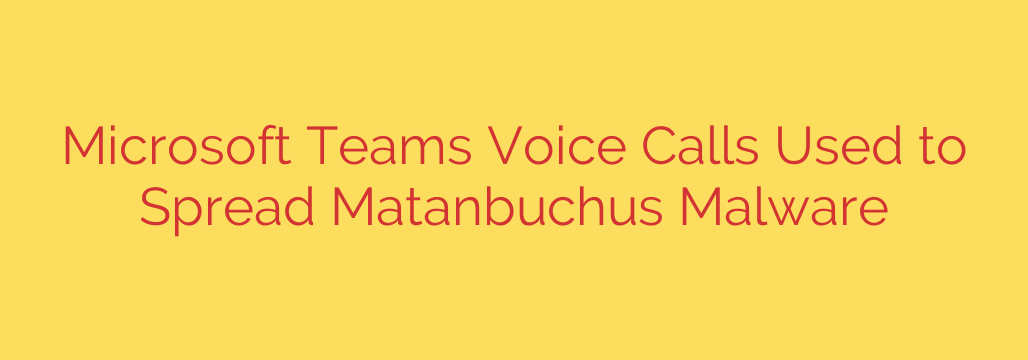
New Phishing Threat: How Cybercriminals Exploit Microsoft Teams to Spread Malware
Microsoft Teams has become an indispensable tool for communication and collaboration in the modern workplace. We trust it for daily chats, video meetings, and file sharing. However, this inherent trust is now being exploited by cybercriminals in a sophisticated new attack designed to infiltrate corporate networks.
A dangerous malware loader known as Matanbuchus is being distributed through carefully crafted Microsoft Teams chat messages, marking a significant shift in how threat actors are targeting organizations. This method cleverly bypasses traditional security measures like email gateways, catching unsuspecting employees off guard.
Deconstructing the Microsoft Teams Attack
The attack is a prime example of social engineering, preying on user trust and curiosity. Here’s how it typically unfolds:
- Initial Contact: The target receives a chat message or a voice call invitation on Microsoft Teams. These messages are often disguised as legitimate business communications, potentially appearing to come from a colleague or a business partner.
- The Lure: The message prompts the user to take action, usually by clicking a link to review a document or join a supposed meeting. The attackers create a sense of urgency or importance to encourage a quick response.
- Malicious Payload: Upon clicking the link, the user is directed to download a file, often a ZIP archive. This file may be deceptively named “Navigating Future Changes” or something similar to appear innocuous.
- Execution and Infection: Inside the ZIP file is an executable that, when run, infects the system. This file establishes a connection with the attacker’s command-and-control servers and downloads the Matanbuchus malware loader.
This attack is particularly effective because it uses a trusted internal communication platform to bypass conventional email security filters. Most organizations have robust defenses against malicious emails, but far fewer are equipped to monitor and block threats coming directly through collaboration apps.
What is Matanbuchus Malware?
Matanbuchus is not the final payload but rather a dangerous “loader” or “dropper.” It operates as a malware-as-a-service (MaaS) tool, sold on the dark web to other cybercriminals.
Its primary function is to gain an initial foothold on a compromised network. Once installed, Matanbuchus acts as a gateway, allowing attackers to deploy more destructive malware. This secondary malware can include:
- Cobalt Strike: A powerful penetration testing tool often used by threat actors for network reconnaissance and lateral movement.
- Ransomware: Malware that encrypts an organization’s critical data, demanding a hefty ransom for its release.
- Spyware and Data Stealers: Tools designed to exfiltrate sensitive company information, credentials, and financial data.
Essentially, Matanbuchus is the key that unlocks the door for more devastating and costly cyberattacks. A single infection can quickly escalate into a full-blown network compromise.
Actionable Security Tips to Protect Your Organization
As threat actors evolve their tactics, businesses must adapt their security posture. Protecting against threats on collaboration platforms like Microsoft Teams requires a multi-layered approach focused on technology, policy, and user education.
Here are essential steps to secure your organization:
- Educate and Train Your Staff: This is the most critical line of defense. Train employees to recognize the signs of social engineering, even on platforms like Teams. Emphasize a “verify before you click” policy for any unexpected links or file downloads, regardless of the source.
- Verify All Unexpected Requests: Instruct users to be highly skeptical of unsolicited messages, especially those from external contacts or ones that contain urgent, unusual requests. If a message seems suspicious, advise them to verify it through a different communication channel (e.g., a direct phone call to the supposed sender).
- Configure Teams Security Settings: Microsoft Teams has built-in security features that can help. Clearly label messages and users from external organizations so employees can immediately identify them. Consider restricting file sharing capabilities with external or guest users if it is not essential for your business operations.
- Strengthen Endpoint Protection: Ensure all devices have a modern, robust endpoint detection and response (EDR) solution. An EDR can identify and block malicious processes and suspicious network activity, offering protection beyond traditional antivirus software that relies on known file signatures.
- Implement the Principle of Least Privilege: Limit user permissions to only what is strictly necessary for their roles. This can contain the damage if an account is compromised, preventing the threat from spreading across the network.
The emergence of malware distribution via Microsoft Teams is a stark reminder that the digital threat landscape is constantly changing. As we embrace new technologies for productivity, we must remain vigilant and proactive in our cybersecurity efforts to protect our critical assets.
Source: https://www.bleepingcomputer.com/news/security/microsoft-teams-voice-calls-abused-to-push-matanbuchus-malware/








